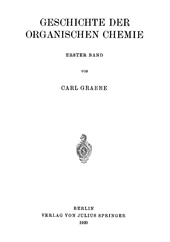Carl Graebe

Carl James Peter Graebe (also: Grabe , born February 24, 1841 in Frankfurt am Main ; † January 19, 1927 ibid) was a German chemist . Together with Carl Liebermann , he succeeded in determining the structure and synthesis of alizarin in 1868 .
biography
Graebe was the eldest son of the Frankfurt merchant and consul from Hesse, Carl Graebe (1797–1879), who did a lot for Frankfurt-Praunheim ; Graebestrasse is named after his father .
Graebe attended the Abel and Simon school for boys and the higher trade school in Frankfurt. In 1858 he began to study mechanical engineering at the Polytechnic in Karlsruhe . In 1860 he moved to Heidelberg , where he studied chemistry with Robert Wilhelm Bunsen . After receiving his doctorate in 1862, he continued his studies in Marburg.
In 1864 he joined the paint works Meister Lucius and Brüning in Höchst as the second chemist . He was responsible for overseeing the then still small fuchsin factory. In addition, he made experiments on the production of iodine violet, which later led to the discovery of iodine green. But by working with iodine, Graebe contracted a protracted ocular inflammation and therefore soon left the factory. After a short time as an office assistant in the Flinsch paper mill, he began a trip to Italy.
After his return in 1865 he came to Adolf von Baeyer , who was then a professor at the trade academy in Berlin . It was the year in which Friedrich August Kekulé von Stradonitz (1829–1896) went public with the new theory of the composition of benzene , groundbreaking for organic chemistry. Graebe took up problems from the field of benzene chemistry. We owe Graebe's research into quinones . This work brought him together with Carl Liebermann in 1868 to determine the chemical structure of the orange-red dye alizarin . This first synthesis of a natural dye has greatly strengthened the reputation of the young German dye industry in the world. In 1869 the two applied for a patent for the production of alizarin from anthracene in Prussia (March 23, 1869), France and England. After negotiations with the Höchster Farbwerke failed, the Badische Anilin- und Sodafabrik produced the synthetic madder red. Graebe also introduced the ortho , meta, and para nomenclature for substitution patterns on the benzene ring.
Graebe completed his habilitation in 1868 and became a private lecturer in Leipzig in 1869. From 1870 to 1877 he was a full professor of chemistry in Königsberg and from 1878 to 1906 in Geneva. After his resignation from the teaching post, Graebe turned to historical tasks in Frankfurt.
Graebe was a Privy Councilor , was awarded several honorary doctorates and held the highest scientific awards, including the 1911 Lavoisier Medal of the Société chimique de France . He was a member, honorary member and corresponding member of numerous scientific associations, including since 1907 President of the German Chemical Society . On November 13, 1887 ( matriculation number 2691 ) he was accepted into the German Academy of Natural Scientists Leopoldina . From 1907 he was a corresponding member of the Prussian Academy of Sciences and from 1913 of the Académie des Sciences in Paris.
In 1920 he published the history of science history of organic chemistry . His grave of honor is located in the Frankfurt main cemetery .
Further work
The Graebe-Ullmann synthesis is named after him and Fritz Ullmann .
literature
- Paul Duden , Herman Decker : Obituary for Carl Graebe. In: Reports of the German Chemical Society . Year 61, issue 2, section A, pp. 9–46, 1928, doi : 10.1002 / cber.19280610237 .
- Wolfgang Klötzer (Hrsg.): Frankfurter Biographie . Personal history lexicon. First volume: A – L (= publications of the Frankfurt Historical Commission. Volume 19, No. 1). Waldemar Kramer, Frankfurt am Main 1994, ISBN 3-7829-0444-3 .
- Documents from the Hoechster archives: Contributions to the history of chemistry, issue 1.
- Berend Strahlmann : Carl Graebe. In: New German Biography (NDB). Volume 6, Duncker & Humblot, Berlin 1964, ISBN 3-428-00187-7 , p. 705 f. ( Digitized version ).
- Elisabeth Vaupel : Carl Graebe (1841-1927) - life, work and activity as reflected in his legacy from letters , university publication Munich, university, dissertation, 1987.
- Member entry of Carl Gräbe at the German Academy of Sciences Leopoldina , accessed on 21 September 2017th
Individual evidence
- ↑ C. Graebe, C. Liebermann: About alizarin and anthracene . In: Reports of the German Chemical Society . tape 1 , no. 1 , 1868, p. 49–51 , doi : 10.1002 / cber.18680010120 ( digitized ).
- ↑ Life data, publications and academic family tree of Carl Gränke at academictree.org, accessed on February 7, 2018.
Web links
- Overview of Carl Graebe's courses at the University of Leipzig (summer semester 1869 to summer semester 1870)
| personal data | |
|---|---|
| SURNAME | Graebe, Carl |
| ALTERNATIVE NAMES | Dig, Carl |
| BRIEF DESCRIPTION | German chemist |
| DATE OF BIRTH | February 24, 1841 |
| PLACE OF BIRTH | Frankfurt am Main |
| DATE OF DEATH | January 19, 1927 |
| Place of death | Frankfurt am Main |


